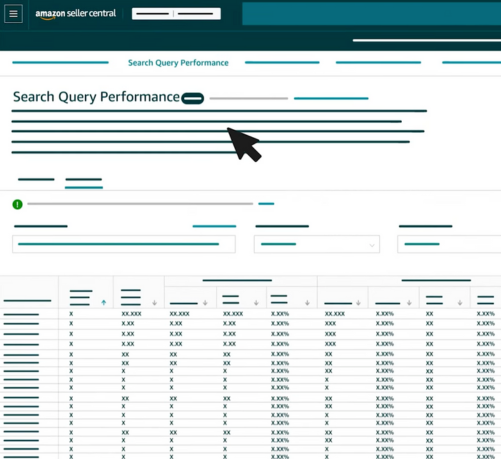Amazon has long been known to have a wealth of data regarding what shoppers want and how they search for it. Given the complex nature of Amazon being both a retailer and a marketplace, this data is shared with brands and retail partners in a few different locations. Similarly, ad products have been developed for each audience of partners over time, leading to even more locations to look for data to inform your brand’s growth strategy. Knowing where to find this data and how to leverage it is incredibly important, especially as competition within Amazon’s marketplace is ever-increasing.
Amazon Brand Analytics
Brand Analytics is a key data source available to Amazon vendors and sellers. However, there are some nuances.
 Amazon Search Query Performance Report
Amazon Search Query Performance Report
The standard Amazon brand analytics that vendors receive does not include the Search Query Performance (SQP) report. On the seller side, the Search Query Performance report is available, however a seller must be registered as the owner of the brand based on their trademark with the US Patent & Trademark Office.
The Amazon Search Query Performance report provides brands with the ability to see the keywords driving their business on a monthly or weekly basis. This enables brands to see the extent to which certain keywords convert shoppers into customers – for branded terms as well as non-branded terms. This helps brands to better understand where investment in ads is needed to drive incremental growth.
Search Frequency Report
Amazon Brand Analytics also includes the Search Frequency Report for both sellers and vendors. This report enables brands to understand what shoppers are searching for most frequently and the top conversion share ASINs against each term on a weekly, monthly, or quarterly basis. This report can be filtered to searches containing specific terms or run as a reverse lookup based on <100 ASINs, including those of your key competitors.
Brands can get a sense of their importance in their category when looking at the search frequency of their branded terms relative to key category terms. This capability also allows for uncovering search volume trends when comparing time periods. Additionally, it provides valuable insight into terms and ASINs for targeting via Amazon sponsored ads, or those that should be included in product titles/descriptions based on changing shopper search behavior.
Amazon Advertising Data
In terms of data provided on the ads side of things, the location and access to data has historically been based on the types of ads used by a brand.
Amazon Marketing Cloud
Amazon Marketing Cloud (AMC), for example, was previously only available to brands utilizing Amazon DSP (a behaviorally targeted programmatic display advertising platform). However, Amazon Marketing Cloud was made available to brands using either Amazon Sponsored search ads or DSP as of their most recent Unboxed event (October 2024).
Learn More About AMC in Our Comprehensive Guide

Amazon Marketing Cloud has a wealth of valuable data and insights, the most noteworthy of which is New-to-Brand (NTB). This metric was previously unavailable for Sponsored Products ads despite generally being the largest area of investment for most brands. Now, with AMC, a brand can see the efficiency of acquiring NTB shoppers across all ad types and even down to individual strategies, such as defensive/branded or generic/category terms. Using this data, brands can make sure to invest in the terms and strategies that deliver the greatest level of incremental growth.
Generally, we measure this based on NTB ROAS, which is the revenue received from shoppers who have not purchased your products on Amazon in the trailing twelve months, divided by ad spend. Alternatively, the cost per New-to-Brand order (or NTB CPA) can also be very informative.
These metrics can be viewed at the product group or product line level to help brands better understand where to allocate advertising budget or where to implement promotional strategies with a goal to increase efficiency of NTB customer acquisition.
Amazon Ad Impression Share of Voice
On the sponsored ads side of things, Amazon has also gradually rolled out Impression Share of Voice reporting for both Sponsored Products & Sponsored Brands. This Amazon report enables you to see actual shoppers’ search terms or ASINs where your targeting reached shoppers, how they were targeted, ROAS, and most importantly the percentage of available ad impressions secured. Within this one report, brands can see which areas of opportunity they have to sharpen targeting and where to raise bids based on performance data to increase share of available Amazon ad impressions.
Third Party Data Sources
In addition to the data Amazon makes available, there are a number of third-party data sources such as Pacvue, Keepa, Jungle Scout, among many others. These tools enable top-of-search paid and organic placement monitoring and reporting of specific search terms to help brands better understand their share of shelf.
Other tools allow for the identification of a competing brand’s entire Amazon catalog of products for targeting or even a brand’s non-first party ASIN for cross-sell targeting to pull buyers to the brand’s preferred offers. Estimated monthly sales volumes can even be obtained to help prioritize ASIN targeting on Amazon.
Benefits to Utilizing Amazon Advertising Data & Reporting
Collectively, the data sources mentioned throughout this article help brands identify how shoppers are finding them, and which terms competitors are winning on.
These tools can also help you see competing ASINs and their conversion share against top terms related to your products. Once targeted, you can then see the percentage of available Amazon ad impressions against those targets and measure the incremental growth they provide your brand when they’re properly added into campaign structures by strategy. Lastly, you can measure gains in Share of Shelf on page 1 of the Amazon search results for key terms based on the inclusion of them and ASIN targets in your strategy.
Leveraging Amazon Advertising Data in Your Marketing Strategy
Some additional ways in which you can leverage all of this Amazon advertising data in your marketing strategy includes:
- Targeting key terms in an exact match format and leveraging top-of-search bid modifiers to allocate advertising budget to top-of-search placements on those terms.
- When targeting ASINs on Amazon, leverage the detail page placement modifier to target those detail pages rather than the terms related to them. This will keep attribution and reporting accurate in order to enable the greatest level of optimization.
- When trying to maximize NTB with a broad portfolio of products, look at the metric at the product group level to identify opportunities to allocate advertising budget to promotions or to other product groups with a more efficient cost per NTB order.
Takeaways: Using Amazon Ads Reporting for Marketing Strategy
- Knowing where to locate Amazon marketing data sources and how to weave them into a cohesive strategy has never been more important. These sources help brands know what to target, how aggressively to go after each target, their impact on the digital shelf, and most importantly how their business has incrementally grown as a result.
- Advertising budgets are often finite, so knowing where and how much to allocate is of paramount importance to maximize customer acquisition.
- Keeping NTB front and center as the key metric driving advertising and promotional budget allocation is key.
- Understand how to leverage the data Amazon provides in disparate locations and formats to help your brand achieve immediate ROI and the greatest long-term value.
Brandwoven welcomes an opportunity to discuss marketing data with your team to explore how we can help you implement a cohesive strategy to grow your brand exponentially on Amazon. Get in touch with our team to schedule a time where we can discuss further.



